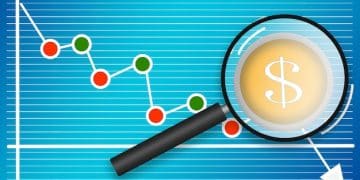Understanding the Impact of Interest Rates on Your Finances

Understanding how interest rates influence everything from mortgages to savings accounts is crucial for prudent financial planning and maximizing your economic well-being.
In the ever-evolving landscape of personal finance, few concepts hold as much sway over our financial health as interest rates. Whether you’re saving for retirement, buying a home, or simply managing your credit card debt, a solid understanding of Understanding the Impact of Interest Rates on Your Finances is absolutely essential.
Understanding the Basics of Interest Rates
Interest rates are, at their core, the cost of borrowing money or the return on lending it. They represent the price you pay to use someone else’s money for a period, or the compensation you receive for letting someone else use yours. This fundamental concept underpins nearly every financial transaction, influencing everything from the grand scale of national economies to the minute details of your personal budget.
Central banks, like the Federal Reserve in the United States, play a pivotal role in setting benchmark interest rates. These rates, often referred to as the federal funds rate, serve as a guide for commercial banks when they lend to each other overnight. Changes in this benchmark rate ripple through the entire financial system, affecting the interest rates banks charge consumers and businesses for loans and the rates they offer on deposits.
How Interest Rates are Determined
Multiple factors influence how interest rates are determined. Beyond central bank policy, market forces, economic indicators, and even global events can shift the landscape. Inflation, for instance, significantly impacts interest rates; when prices rise, lenders typically demand higher interest rates to compensate for the eroded purchasing power of future repayments. Economic growth also plays a role; a strong economy often translates to higher demand for credit, pushing rates up. Conversely, during periods of economic slowdown, lower interest rates might be used to stimulate borrowing and investment.
- Inflation: Higher inflation usually leads to higher interest rates as lenders seek to maintain the real value of their money.
- Economic Growth: A robust economy often sees interest rates rise due to increased demand for credit.
- Central Bank Policy: Decisions by institutions like the Federal Reserve significantly influence short-term rates.
- Supply and Demand for Credit: The basic economic principle of supply and demand also affects the cost of money.
Ultimately, understanding these basic mechanisms is the first step toward appreciating the profound sway interest rates hold over your personal financial decisions. They are not merely abstract numbers but concrete figures that can either accelerate your financial progress or impede it, depending on how you navigate their fluctuations.
Interest Rates and Your Borrowing Power
The relationship between interest rates and your ability to borrow money is direct and undeniable. When interest rates are low, borrowing becomes cheaper, making large purchases like homes or cars more accessible and affordable. Conversely, when rates climb, the cost of borrowing increases, potentially pricing some individuals out of the market or making existing loans more expensive.
Mortgages are perhaps the most common and impactful example of how interest rates affect borrowing. A small shift in the mortgage rate can translate into thousands of dollars over the lifetime of a 15-year or 30-year loan. For homebuyers, this means that even a quarter-point rise in rates can significantly increase monthly payments and the total cost of a home.

Credit cards are another area where interest rates play a critical role, arguably even more so due to their often-variable nature. A high annual percentage rate (APR) on a credit card can quickly turn a small balance into a significant debt burden if not managed carefully. Personal loans and auto loans are also sensitive to interest rate changes, affecting both the monthly payment and the total amount paid back.
Impact on Different Types of Loans
Each type of loan has unique characteristics that determine how sensitive it is to broad interest rate movements. Fixed-rate mortgages offer stability, as the interest rate and monthly payment remain constant for the loan’s duration, protecting borrowers from future rate hikes. Adjustable-rate mortgages (ARMs), however, present a different scenario. Their interest rates fluctuate with market conditions after an initial fixed period, meaning your payments could increase significantly if rates rise. This variability can be a double-edged sword, offering lower initial payments but introducing future uncertainty.
- Mortgages: Fixed-rate mortgages offer payment stability, while adjustable-rate mortgages (ARMs) can lead to fluctuating payments.
- Credit Cards: Typically have variable rates, meaning interest charges can increase as benchmark rates rise.
- Auto Loans: Generally fixed, but higher rates make new car purchases more expensive.
- Personal Loans: Can be fixed or variable; higher rates increase the cost of borrowing for personal needs.
Essentially, the interest rates available at any given time dictate the financial feasibility of taking on new debt. Being aware of current rate trends and understanding their implications for different loan types is vital for making informed borrowing decisions that align with your financial goals and capabilities.
Interest Rates and Your Savings & Investments
Just as interest rates influence the cost of borrowing, they also dictate the returns you can expect on your savings and investments. For savers, higher interest rates mean a greater return on deposited funds, encouraging accumulation. Conversely, low interest rates can disincentivize traditional savings accounts, prompting individuals to seek higher yields elsewhere.
Savings accounts, certificates of deposit (CDs), and money market accounts are directly responsive to interest rate changes. When the Federal Reserve raises rates, banks typically follow suit, offering slightly better returns on these deposit products. While these increases might seem modest, over time, the compounding effect can significantly boost your savings. For example, a CD locked in at a higher rate can provide predictable, enhanced returns for its term.
Yields Across Different Investment Vehicles
The impact extends beyond basic savings to various investment vehicles. Bonds, for instance, are highly sensitive to interest rate fluctuations. When new bond yields rise, the value of existing bonds with lower fixed interest rates tends to fall, as they become less attractive to investors. This inverse relationship is a critical consideration for those with bond portfolios.
For equity markets, the relationship is more nuanced. Higher interest rates can make borrowing more expensive for companies, potentially slowing economic growth and reducing corporate profits, which can negatively impact stock prices. Additionally, higher bond yields make equities relatively less attractive, as investors can get a decent return with lower risk. However, strong economic conditions that lead to higher rates can also boost corporate earnings, creating a complex interplay.
- Savings Accounts & CDs: Directly benefit from rising rates, offering higher returns on deposits.
- Bonds: Experience an inverse relationship; rising rates devalue existing fixed-rate bonds.
- Stocks: Affected indirectly; higher rates can increase borrowing costs for companies and make bonds more appealing, but strong economy can support stock growth.
- Money Market Accounts: Offer competitive, variable rates that quickly adjust to changes in the federal funds rate.
Understanding these dynamics is crucial for optimizing your investment strategy. During periods of rising rates, you might consider locking in higher yields on new CDs or adjusting your bond portfolio. In a low-rate environment, the search for higher returns might lead you towards a more diversified investment strategy that includes equities, though always with an awareness of the associated risks.
The Connection Between Interest Rates and Inflation
The dance between interest rates and inflation is one of the most critical relationships in macroeconomics, influencing everything from the price of groceries to the value of your savings. Inflation refers to the rate at which the general level of prices for goods and services is rising, and consequently, the purchasing power of currency is falling. Interest rates are a primary tool used by central banks to manage this economic phenomenon.
When inflation begins to accelerate, central banks often raise interest rates as a measure to cool down the economy. Higher interest rates make borrowing more expensive for consumers and businesses, which can reduce spending and investment. This reduction in demand helps to alleviate inflationary pressures by bringing aggregate demand more in line with supply, thereby stabilizing prices. Conversely, if inflation is too low or deflation is a concern, central banks might lower interest rates to encourage borrowing and stimulate economic activity, aiming to nudge inflation upwards towards a desired target.
Inflation’s Impact on Your Money
The real value of your money, particularly your savings, is constantly challenged by inflation. If your savings account yields 1% interest, but inflation is running at 3%, your money is actually losing purchasing power in real terms. This “inflation tax” erodes the wealth of savers, making it crucial to find investments that can at least keep pace with or ideally, outpace inflation.
Moreover, inflation can affect the cost of borrowing even before interest rates adjust. Lenders incorporate inflation expectations into the interest rates they charge. If they anticipate higher inflation, they will demand a higher nominal interest rate to ensure they earn a positive real return on their loans. This means borrowers might face higher rates even before a central bank formally announces a rate hike, based on market expectations.
- Purchasing Power: Inflation erodes the value of your money, making it crucial for investments to beat inflation.
- Lender Behavior: Lenders factor in inflation expectations when setting loan rates to ensure a real return.
- Central Bank Response: High inflation often prompts central banks to raise rates to curb spending.
- Economic Stability: Managing interest rates to control inflation is key to maintaining a stable economy.
Understanding this intricate feedback loop is essential for sound financial planning. It underscores the importance of not just looking at the nominal interest rate on your savings or loans, but also considering the real interest rate – the nominal rate minus the inflation rate – to gauge the true impact on your financial standing.
Strategies for Navigating Fluctuating Interest Rates
Living in an economy where interest rates are constantly in flux demands a proactive approach to personal finance. Developing strategies to adapt to these changes can help you minimize risks and maximize opportunities, whether rates are rising or falling. The key lies in understanding your current financial position and anticipating how rate changes might impact your specific circumstances.
When interest rates are on the rise, prioritizing debt reduction, especially high-interest, variable-rate debts like credit card balances, becomes crucial. Paying down these debts quickly can save you significant amounts in interest payments. For those with variable-rate mortgages, considering a refinance to a fixed-rate loan might offer long-term stability and protection against further payment increases. On the savings side, rising rates provide an excellent opportunity to lock in higher yields on new certificates of deposit or explore money market accounts that offer better returns.
Adapting Your Financial Plan
Conversely, in a declining interest rate environment, the focus shifts. This is an opportune time to refinance existing loans with high fixed rates, such as mortgages, student loans, or personal loans, to secure lower payments and reduce overall cost. While savings accounts might offer lower returns, it can be a good time to consider investments that perform well in low-rate environments, such as certain types of dividend stocks or real estate. It’s also an excellent time to take on new, larger loans for investments like purchasing a home or funding a business, as the cost of borrowing is more favorable.
Regularly reviewing your financial portfolio and adapting your strategies based on interest rate forecasts is not just sound advice; it’s a necessity. This includes evaluating your debt-to-income ratio, assessing your liquidity, and diversifying your investments to mitigate risks associated with rate changes. It’s about being nimble and making informed decisions rather than reactive ones.
- Debt Prioritization: Focus on paying off high-interest, variable-rate debt during rising rate periods.
- Refinancing Opportunities: Consider refinancing loans to lower rates when rates are falling.
- Savings Optimization: Lock in high CD rates when they’re available; seek better yields during low-rate periods.
- Investment Diversification: Adjust your portfolio to align with current and anticipated interest rate trends.
By implementing these strategies, you empower yourself to navigate the complexities of interest rate fluctuations, transforming potential threats into opportunities for financial growth and security. This adaptive mindset ensures your financial plan remains robust against economic shifts.
Case Studies: Real-World Impacts of Rate Changes
To truly grasp the significance of interest rates, it is helpful to examine real-world scenarios where their movements have had tangible consequences on individuals and the broader economy. These case studies illustrate the direct and indirect impacts, providing concrete examples of how theory translates into practical financial outcomes.
Consider the housing market during periods of significant rate changes. In the early 2000s, historically low interest rates fueled a housing boom, making mortgages incredibly affordable. This encouraged widespread homeownership and significant investment in real estate. However, as rates began to climb towards the mid-2000s, combined with other factors, the affordability of mortgages decreased, contributing to a slowdown in housing sales and, eventually, the housing market crisis. This period starkly demonstrated how the cost of borrowing can amplify or contract economic sectors.
Personal Financial Examples
On a more personal level, imagine someone who took out a variable-rate auto loan in a low-interest environment. If the Federal Reserve subsequently raises rates, their monthly car payments could increase, squeezing their budget. This unpredictable expense highlights the risk associated with variable-rate debts, especially for significant purchases. Conversely, someone with substantial savings in a high-yield savings account or CD would rejoice as rising rates meant a bigger return on their money, bolstering their financial safety net.
Another compelling example involves small businesses. Many rely on lines of credit or loans to manage cash flow and fund expansion. When interest rates rise, the cost of these loans increases, reducing their profitability and potentially hindering growth or even leading to layoffs. During periods of falling rates, however, businesses find it cheaper to borrow, which can stimulate investment, hiring, and overall economic expansion.
- Housing Market Swings: Low rates can spur booms; rising rates can contribute to slowdowns or crises.
- Variable-Rate Debtors: Face increased monthly payments if rates rise, impacting personal budgets.
- Savers’ Gains: Benefit from higher returns on deposits and fixed-income investments during rate hikes.
- Business Investment: Cheaper borrowing costs due to low rates can stimulate business growth and job creation.
These examples underscore that interest rate changes are not merely abstract economic data points. They have profound, immediate, and lasting effects on individuals’ budgets, investment choices, and the broader economic landscape, making their understanding paramount for informed financial decisions.
Future Outlook: What to Expect from Interest Rates
Predicting the future of interest rates is notoriously challenging, even for seasoned economists. However, understanding the factors that typically influence central bank decisions and broader market trends can provide a framework for anticipating potential shifts. This forward-looking perspective is crucial for effective long-term financial planning.
Currently, central banks worldwide closely monitor key economic indicators such as inflation rates, employment data, and GDP growth. Persistent high inflation, for example, often signals a need for higher interest rates to cool down an overheating economy. Conversely, signs of a recession or significant economic slowdown might prompt central banks to lower rates to stimulate borrowing and investment. Geopolitical events and global economic conditions also play an increasingly significant role, as interconnected markets mean that a crisis in one region can ripple outwards, influencing interest rate policies everywhere.
Preparing for Future Scenarios
For individuals, preparing for future interest rate scenarios involves a proactive assessment of their financial vulnerabilities and opportunities. If market consensus suggests rates are likely to rise, now might be the time to lock in fixed rates on any potential new loans or to accelerate payments on variable-rate debts. Conversely, if a period of stable or declining rates is anticipated, exploring refinancing options or considering investments that generally perform well in such environments could be beneficial.
Diversification across various asset classes remains a cornerstone of prudent financial management, regardless of interest rate forecasts. A well-diversified portfolio is better equipped to weather different economic conditions, including unexpected rate movements. Staying informed through reputable financial news sources and consulting with a financial advisor can also provide valuable insights and tailored guidance specific to your situation.
- Economic Indicators: Monitor inflation, employment, and GDP for clues on central bank actions.
- Geopolitical Influence: Global events can impact domestic interest rate policies.
- Proactive Planning: Adapt debt and savings strategies based on rate forecasts.
- Diversification: A diversified portfolio helps mitigate risks from unexpected economic shifts.
Ultimately, while no one can know the future with certainty, making informed assumptions about potential interest rate movements and adjusting your financial strategy accordingly can help you maintain resilience and capitalize on emerging opportunities in an ever-changing economic landscape.
| Key Point | Brief Description |
|---|---|
| 📊 Borrowing Costs | Higher rates mean more expensive loans (mortgages, credit cards); lower rates make borrowing cheaper. |
| 💰 Savings Returns | Higher rates increase returns on savings accounts and CDs; low rates yield minimal returns. |
| 📈 Inflation Link | Central banks use interest rates to control inflation, affecting purchasing power. |
| 🛡️ Financial Strategy | Adapt personal finance decisions (debt, investments) based on rate trends. |

Frequently Asked Questions About Interest Rates
The federal funds rate is the target interest rate set by the Federal Reserve for overnight borrowing between banks. While you don’t directly pay this rate, it serves as a foundational benchmark that influences other interest rates across the economy, including those on mortgages, credit cards, and savings accounts, thereby indirectly affecting your personal finances.
Most credit cards have variable interest rates, meaning they can change. When interest rates rise, your credit card’s annual percentage rate (APR) typically increases, leading to higher minimum payments and a greater total cost of debt if you carry a balance. This underscores the importance of paying down credit card debt, especially in a rising rate environment.
When rates are low, a fixed-rate mortgage locks in that low rate for the entire loan term, providing payment stability. An adjustable-rate mortgage (ARM) might offer an even lower initial rate, but it carries the risk of higher payments if rates rise after the fixed period. Your choice depends on your risk tolerance and how long you plan to stay in the home.
When interest rates are high, you can benefit by moving your savings into accounts that offer better returns, such as high-yield savings accounts or Certificates of Deposit (CDs). Locking in a CD with a higher rate can provide guaranteed returns for a set period, maximizing the growth of your money without market volatility.
Yes, indirectly. Higher interest rates can increase borrowing costs for companies, potentially reducing their profits and making them less attractive to investors. They also make fixed-income investments, like bonds, more appealing compared to stocks. However, the exact impact can vary significantly based on other economic factors and company-specific performance.
Conclusion
The intricate ballet of interest rates continually reshapes our financial landscape. From the cost of borrowing for a home to the returns on our hard-earned savings, these seemingly abstract numbers have a profoundly tangible impact on everyday financial decisions. Developing a nuanced understanding of their movements, especially in relation to inflation and economic forecasts, empowers you to make strategic choices that optimize your budgets, investments, and overall financial well-being. By staying informed and adapting your approach, you can navigate the complexities of interest rate fluctuations, transforming what might seem like challenges into opportunities for growth and resilience.





